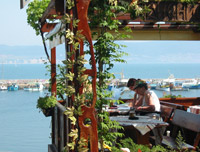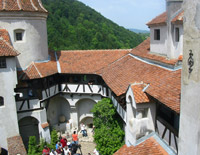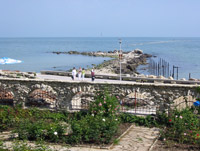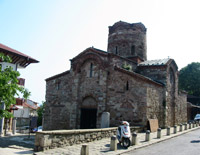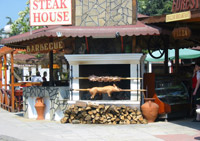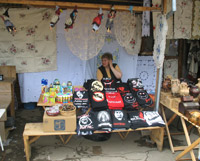Discoveries in Bulgaria and Romania
by M. Lewis Stein, Irvine, CA
As we crossed the border from Turkey into Bulgaria, our guide, Borut Sraj, a 55-year-old Slovenian who wore a tiny flute around his neck to alert laggards when the bus was leaving, advised us, “The country may or may not work for you, but take it as it comes.”
It was sound advice for those whose European travels focused mainly on France, Italy, Spain and other countries in the western part of the continent. My wife, Barbara, and I had been in former Soviet-bloc nations, including Russia, Poland, Estonia and the Czech Republic, but we had a hankering to visit Bulgaria and Romania.
Beginning in Bulgaria
My and my travel agent’s research turned up only one tour company, Insight Vacations (Anaheim, CA; 888/680-1241, www.insightvacations.com), that offered the two countries in a single land package.
Our May ’07 tour, called “Aegean Danube & Black Sea Explorer,” which began in Istanbul and ended in Athens, was only the second trip for Insight through this region of Eastern Europe. Of the 37 travelers who signed up for it, only 10 of us were Americans, the others being Australians, Canadians, British and a sprinkling of other Europeans.
Our first overnight in Bulgaria was at Sunny Beach on the Black Sea, a somewhat frowzy resort area that attracts a lot of Europeans seeking cheap vacations. Its main drag has eateries with names like Wild West and Pizza House.
One early lesson we learned in Bulgaria is that credit cards are virtually useless there. Even the Metropolitan, where we stayed, one of the best hotels in town, didn’t accept them. Our stay, of course, was prepaid, but when I asked a desk receptionist how they handled reservations without a credit card, she replied, “Your company will take care of it.”
“What if I’m an individual traveler with no company affiliation,” I went on. She shrugged.
The currency in Bulgaria is the leva, which can leave you with a lot of useless coins once you quit the country. Barbara and I had been in Germany and Austria before connecting with Insight and we immediately missed the border-crossing euro.
Day-tripping
Sensing that we were not enchanted with Sunny Beach, Borut offered to bus us five miles to Nessebar, a delightful contrast to our base.
The town of 10,000 people dates from the second century B.C., beginning as a Thracian fishing village. Remains of its Greek and, later, Roman and Turkish domination are everywhere, including several of its once 41 churches plus aqueducts, fortified walls, an amphitheater, medieval paving and a well-preserved Temple of Apollo.
The colorful streets were ideal for strolling along the shops and several odd bazaars, which sold such curios as old Soviet military insignia and uniforms, Nazi swastikas and vintage pocket watches.
An optional tour from Sunny Beach to Balchik, Bulgaria, and the summer palace of Queen Marie of Romania was a delightful excursion, although at $60 a head they might have thrown in lunch.
The palace and its chapel on the Black Sea coast are beautifully preserved. The complex includes a botanical garden with more than 3,000 species of rare plants that is now a part of the University of Sofia’s teaching program.
The harbor town of Balchik was itself interesting with its steep, pebbled streets and stone and adobe houses.
On to Romania
We rolled out of Sunny Beach for a 5-hour ride to Sofia (with breaks) along farmland dotted with modern, low-slung buildings on what appeared to be fertile soil. However, there wasn’t a human being in sight. Borut explained that the structures were the legacy of the Soviet-era collective farm system, which collapsed along with Communist rule here.
We continued on to Romania’s capital, Bucharest. As we entered the outskirts of the city, the concrete rows of drab, Soviet-style apartment buildings were deceiving in terms of what lay ahead.
Actually, the city contains a number of architectural gems, both modern and ancient. However, the Parliament Palace, formerly known as Casa Poporului, or the People’s House, is not one of them — unless sheer size is a criterion. The edifice, at more than three million square feet, is the second-largest office building in the world, topped only by the Pentagon.
Built as a monument to the late dictator Nicolae Ceausescu’s megalomaniacal ego, it has turned out to be a fairly good deal for the government, housing its parliament and serving as a tourist attraction with a $7 entrance fee — $15 if you’re carrying a camera.
We approached the structure along one of Bucharest’s handsome thoroughfares, Bulevardul Unirii (Unity Boulevard), which our local guide described as “our Champs-Élysées.” When someone in our party pointed out that, unlike the famed Paris artery, the street had no cafés or shops lining its route, she assured us, “ There will be. That’s our next step.”
Ceaus¸escu’s vanity aside, Bucharest has a slew of buildings that treat the eye. Among them are the School of Architecture, with its richly ornamented pillars and carvings; the Antim Monastery (circa 1715), near the Parliament Palace, built in stunning Brâncovenesc style; the neoclassic University of Bucharest; the National Theatre, with its vaulted entrance, and the 16th-century Old Court Church, the city’s oldest church.
There’s also plenty of interesting architecture around University Square, a popular gathering area and a site of riots and protests during the 1989 revolution that ended Ceaus¸escu’s rule and brought about his execution. Just below the square there’s an underground passage with shops and restaurants.
Heading back to Bulgaria
I wished we could have spent a third day in Bucharest, particularly since our next stop was “Dracula town” — officially, Bran — where, according to Borut, we would find “all the souvenir junk in the world.” He forgot to mention Dracula beer.
The village lies below Bran Castle, erroneously cited as the abode of Vlad T¸epes¸ (the Impaler), supposedly the model for Bram Stoker’s “Dracula.”
The historical fallacies do not matter to the hundreds of tourists who throng the town daily, lugging home Dracula T-shirts, masks, miniature caskets and other paraphernalia linked to the count who never was.
From Bucharest, we doubled back to Sofia, Bulgaria’s capital, and the Hilton Sofia, one of the classiest hotels I’ve ever stayed in. Again, we seemingly were the only vacationers, but the lobby, restaurant and bars were loaded with American and European business types, no doubt taking advantage of Bulgaria’s fast-moving economy.
There wasn’t much time for sightseeing in Sofia, but we were lucky enough to be in the gold-domed Alexander Nevsky Cathedral while an Eastern Orthodox service was in progress, featuring a splendid choir.
If I return, I would spend more time strolling Sofia’s boulevards paved with yellow Viennese cobblestones and visiting the Sofia Synagogue, the largest in the Balkans, not to mention the sixth-century Byzantine church of St. Sophia.
There’s a good chance I will go back to both countries.
The entire 14-day tour cost $2,250 per person and included 12 buffet breakfasts and six dinners. All hotels were first class and the pace was leisurely, with two or three nights at each stop.


